Vetches are common wild plants or can be grown as forage and food crops. We give an overview of sweet pea species, their requirements and possible uses.
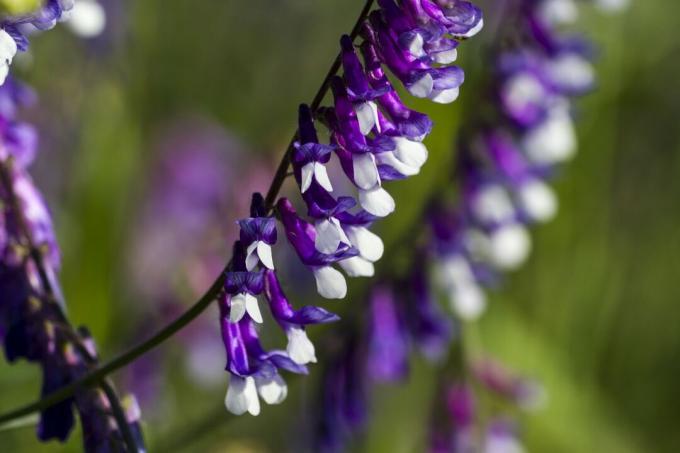
sweet peas (vicia) are plants that can be used in a variety of ways: They are sometimes cultivated as animal feed, food, green manure or for decoration. We present some types of vetches and give tips on planting vetches in the garden.
contents
- Sweet peas: origin and properties
- The most beautiful types and varieties of sweet peas
- Are vetches weeds?
- plant vetch
- The right location
- sow vetch
- Vetch as green manure
- The right care
- Which sweet peas are hardy?
- Are sweet peas poisonous or edible?
Sweet peas: origin and properties
Vetches belong to the legume family (Fabaceae), are represented by numerous species in the temperate zone of the northern hemisphere and are therefore also widespread in Europe. The Vetchling (lathyrus) is also known as sweet peas or sweet peas, but is not closely related to real vetches. Most vetch species are annuals, but there are also hardy and perennial plants.
Sweet peas are often filigree plants with thin stems that grow creeping to climbing. An exception is the vigorous and upright broad bean (Vicia faba). On average, the plants reach a height of between 30 and 100 cm, but can also grow up to 200 cm. Sweet peas form a dense and deep network of roots. Typical for papilionaceous plants vetches also develop a symbiosis with soil bacteria, the so-called rhizobia (Rhizobium), a. These settle in round nodules on the roots and bind nitrogen, which they make available to the plant in exchange for sugar from photosynthesis. This enables the vetch to survive on very poor, nitrogen-poor soils.
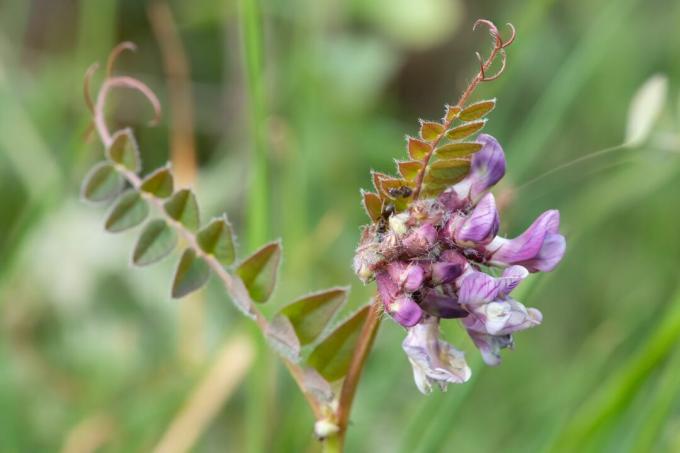
The leaves of the vetch, consisting of up to thirteen pairs of leaflets, are arranged alternately, pinnate in pairs and ovate, elliptical to lanceolate in shape. They usually end in a fine tendril. The yellow, white, red-violet or blue-violet butterfly flowers sit individually or together in a multi-flowered, long raceme. The flowering time of the vetch is in summer between June and August. Vetches can self-pollinate, but cross-pollination is not uncommon as the flowers provide large amounts of nectar. Vetches are therefore often part of bee pastures. After fertilization, elongated, flat to rounded pods form, containing two to eight round or flat seeds. Vetch seed can be creamy white, beige, light brown to reddish brown. When the seeds are ripe, the dry pods burst open and some of the vetch seeds are thrown out.
How deep do sweet peas root? Vetch are deep-rooters. Exactly how deep they root depends on various site factors such as soil type. On suitable soil, the vetch roots reach a depth of more than 100 cm.
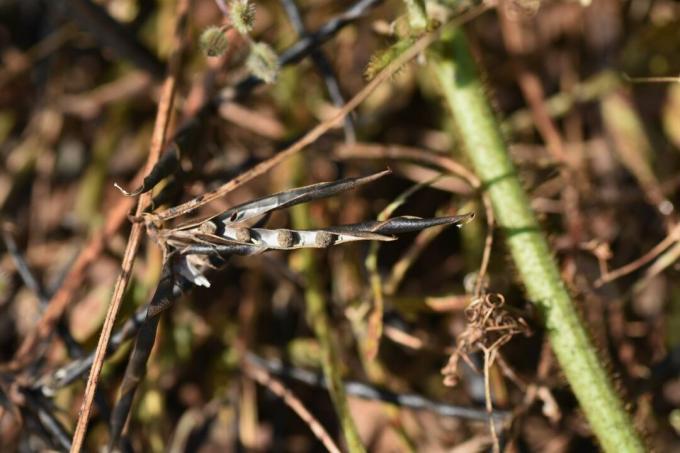
The most beautiful types and varieties of sweet peas
Numerous vetch species are widespread in Europe and sometimes also appear as wild plants in the garden. Some sweet peas can be eaten as a vegetable or green manure to use. We give an overview of the most beautiful types and varieties.
- broad bean (Vicia faba): Well-known vegetable species with strongly upright plants, pinnate leaves and large, white, darkly striped or red flowers with a black eye. This develops into pods with thick seeds, which are also known as broad beans or broad beans. Popular varieties are 'Bioro', 'Hangdown', 'Tiffany', 'Ratio' or 'Reina Mora'.
- Pea Vetch (Vicia pisiformis): Climbing, perennial and hardy vetch with large pods and round, pea-like seeds. When young, they can be used like mangetout, dried like pear peas.
- Wire-haired Vetch (Vicia hirsuta): A common vetch species that grows up to 50 cm high in grain fields, dry meadows or roadsides. The rough hairiness of the leaves and the soft hairiness of the two-seeded pods are typical. The rough-haired vetch flowers from June to August and has light purple to whitish, rather small flowers.

- sweet pea (Vicia sativa): Widely used annual cover crop, especially for nitrogen-hungry vegetables such as cabbage (Brassica). The vigorously growing, up to 80 cm high, deep-rooted sweet peas form red-violet flowers and at the same time serve as bee pasture. It is also used for forage production.
- Vetch (Vicia ervilia): One of man's very first crops, now rarely cultivated and how lenses (Lens culinaris) is prepared. It was therefore also given the nickname Linseed Vetch. The extremely protein-rich seed thrives on filigree, approximately 50 cm high plants with red-violet flowers and later elongated pods with creamy-white vetch seeds.
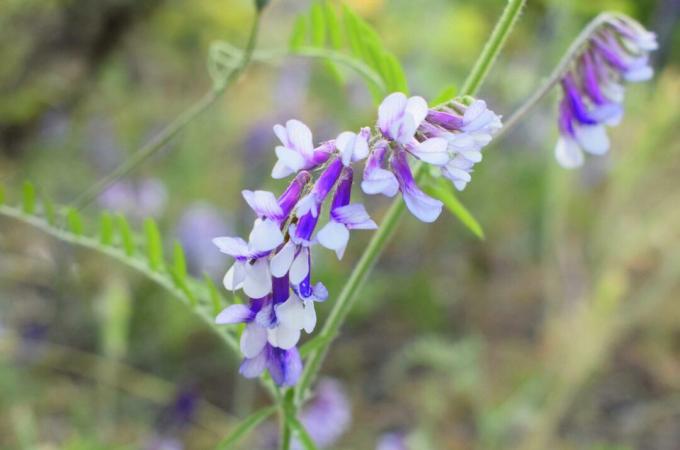
- tufted vetch (Vicia cracca): Lying to climbing vetches, 30 – 100 cm high, widespread in Europe. It forms dark purple-blue flowers in long clusters of 10 - 30 and blooms between June and August.
- forest vetch (Vicia sylvatica): Species occurring mainly in mountain forests at altitudes of up to 2000 m. The prostrate to climbing plants can reach a height of 50 - 200 cm. They form long clusters of white, violet-veined butterfly flowers from June to August.

- sweet pea (Vicia sepium): Widespread, 30 - 60 cm high, climbing vetches species, which keeps itself upright by means of its tendrils. Between May and August it forms several clustered, violet-striped butterfly flowers.
- shaggy vetch (Vicia villosa): Also known as winter vetch, a cold-tolerant green manure plant with soft hairs on the stem, leaves and calyx. The deep-rooted shaggy vetch, which blooms in red-purple clusters, collects nitrogen in the soil, serves as bee pasture and can also be used as animal feed. For example, they are part of the well-known seed mixture "Landsberger Gemenge".
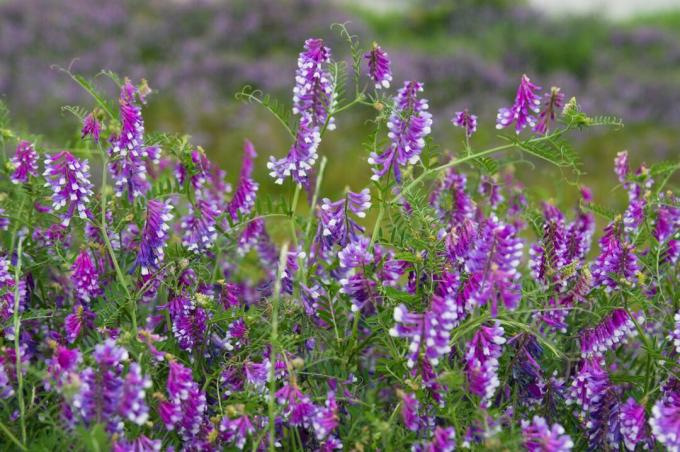
Are vetches weeds?
Essentially, vetches are extremely useful plants, as they provide food for insects, root vigorously in the subsoil and bind nitrogen. Vetches are indicator plants for low-nitrogen soils and can grow stronger on such locations than other plants because they have their own supply of nitrogen thanks to the nodule bacteria respectively. For example, vetches can settle in places in the lawn and as unwanted weeds in beds and spread quickly. Especially on green areas ensures a regular lawn fertilization that grasses become more competitive and vetch disappear again. In beds, unwanted vetch can be manually removed before seed formation.
plant vetch
Vetches are adaptable plants and also thrive on difficult soils. We give tips on the location and sowing of vetch.
The right location
The ideal location for vetch is on deep, moisture-retaining, nutrient-poor soil in full sun to partial shade. They also thrive on heavy soil as long as there is no waterlogging. The optimal pH value of the soil is between 6.2 and 7.2 in the slightly acidic to neutral range.
sow vetch
Sweet peas should be sown directly into the bed. Pre-cultivation is not necessary, but possible with field beans to make them earlier. The dark germs are sown about 5 cm deep into the ground from March to April. The planting distance is about 10 cm. With regular watering and an optimal germination temperature of 8 - 15 °C, the first seedlings will appear after one to three weeks. Sweet peas are rarely sown as a single species, as they are included in numerous flowering mixtures. Our Plantura bee pasture In addition to summer vetch, it contains over twenty other bee-friendly species that bloom at different times and thus provide food well into autumn. One pack of our seed mix is sufficient for up to 20 m2 bed area.
Vetch as green manure
Vetches produce a lot of organic matter quickly, root deeply and introduce nitrogen into the soil. All of these advantages make vetches ideal cover crops. For use as a nitrogen-enriching winter green cover, annual, freezing vetch species such as summer vetch are usually chosen. Alternatively, the frost-tolerant winter vetch can be used as green manure. It is cut, mulched and raked in in the spring to incorporate the organic matter into the soil. Vetches are sown for green manure in late summer from August to September.

The right care
Vetches are easy-care plants, they do not require fertilization or pruning. However, during the young plant phase, they should be watered regularly in dry, hot weather. After germination, it may be necessary to remove unwanted weeds until the vetches have become competitive. This is particularly important for vetch and field beans, also to simplify harvesting. Green manure does not require any maintenance other than initial watering until the plants are mulched.
Sweet peas are easy to propagate as they usually form numerous seeds. The pods are harvested at seed maturity, when they become increasingly dry and brown, and laid out to dry for a few days. They then often open by themselves or are gutted to collect the vetch seeds. They can easily be stored in a dry, cool and dark place for four to five years without losing their ability to germinate.
Which sweet peas are hardy?
Winter-hardy vetch species are the pea vetch, bird vetch, wood vetch, winter vetch and wire vetch. Some of them die above ground in late autumn and sprout fresh or stay green until spring. Perennial sweet peas are completely hardy and do not require any winter protection in the garden.

Are sweet peas poisonous or edible?
Basically, vetches are not poisonous. The tender shoots and blossoms of the fence vetch or bird vetch, for example, can be eaten raw. However, the green pods and seeds contain slightly toxic alkaloids that serve to protect against being eaten. Heat destroys these harmful molecules, which is why vetch can be eaten cooked, boiled, or blanched without worry. All parts of the pea vetch can also be eaten raw. Vetch seeds can be prepared like lentils, but require a long soaking and cooking time.
The large family of legumes also includes the lupins (lupinus). With us you can read which species are suitable as attractive garden perennials or for growing edible lupine seeds and how to successfully grow them in the garden.
